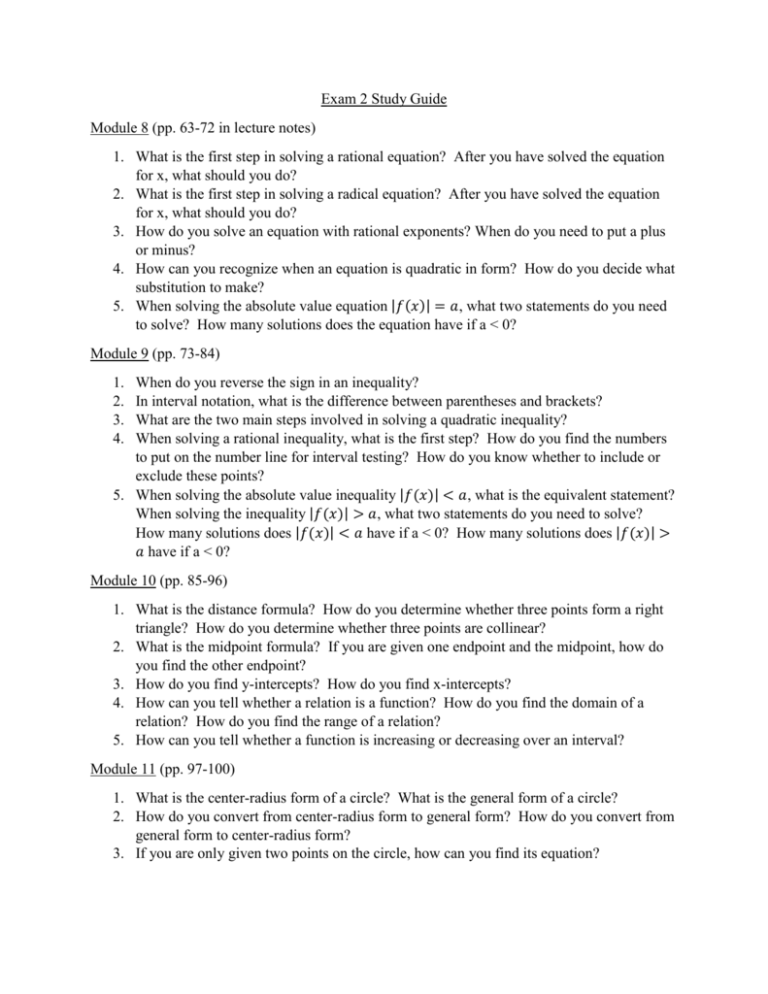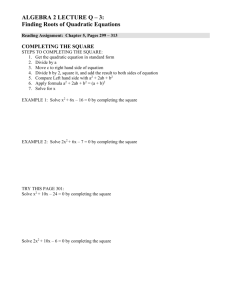Exam 2 Study Guide
advertisement

Exam 2 Study Guide Module 8 (pp. 63-72 in lecture notes) 1. What is the first step in solving a rational equation? After you have solved the equation for x, what should you do? 2. What is the first step in solving a radical equation? After you have solved the equation for x, what should you do? 3. How do you solve an equation with rational exponents? When do you need to put a plus or minus? 4. How can you recognize when an equation is quadratic in form? How do you decide what substitution to make? 5. When solving the absolute value equation |𝑓(𝑥)| = 𝑎, what two statements do you need to solve? How many solutions does the equation have if a < 0? Module 9 (pp. 73-84) 1. 2. 3. 4. When do you reverse the sign in an inequality? In interval notation, what is the difference between parentheses and brackets? What are the two main steps involved in solving a quadratic inequality? When solving a rational inequality, what is the first step? How do you find the numbers to put on the number line for interval testing? How do you know whether to include or exclude these points? 5. When solving the absolute value inequality |𝑓(𝑥)| < 𝑎, what is the equivalent statement? When solving the inequality |𝑓(𝑥)| > 𝑎, what two statements do you need to solve? How many solutions does |𝑓(𝑥)| < 𝑎 have if a < 0? How many solutions does |𝑓(𝑥)| > 𝑎 have if a < 0? Module 10 (pp. 85-96) 1. What is the distance formula? How do you determine whether three points form a right triangle? How do you determine whether three points are collinear? 2. What is the midpoint formula? If you are given one endpoint and the midpoint, how do you find the other endpoint? 3. How do you find y-intercepts? How do you find x-intercepts? 4. How can you tell whether a relation is a function? How do you find the domain of a relation? How do you find the range of a relation? 5. How can you tell whether a function is increasing or decreasing over an interval? Module 11 (pp. 97-100) 1. What is the center-radius form of a circle? What is the general form of a circle? 2. How do you convert from center-radius form to general form? How do you convert from general form to center-radius form? 3. If you are only given two points on the circle, how can you find its equation? Module 12 (pp. 101-110) 1. What is the domain and range of a line that is neither horizontal nor vertical? What about a horizontal line? What about a vertical line? 2. What is the standard form of a line? What is point-slope form? What is slope-intercept form? 3. What is the equation for finding the slope of a line? What is the slope of a horizontal line? What is the slope of a vertical line? 4. What is the equation of the vertical line through the point (a,b)? What is the equation of the horizontal line through the point (a,b)? 5. What characteristic tells you that two lines are parallel? What is the relationship between the slopes of perpendicular lines? What kind of line is perpendicular to a horizontal line? Module 13 (pp. 111-114) 1. How can you tell where a function is not continuous? 2. What do the graphs of the following equations look like: 𝑦 = 𝑥, 𝑦 = 𝑥 2 , 𝑦 = 𝑥 3 , 𝑦 = √𝑥, 𝑦 = ∛𝑥, 𝑦 = |𝑥|? 3. How do you graph a piecewise-defined function? Module 14 (pp. 115-120) 1. How do you test for symmetry with respect to the y-axis? With respect to the x-axis? With respect to the origin? 2. How do you determine whether a function is even or odd? What type of symmetry do odd functions have? What type of symmetry do even functions have? 3. How can you tell the difference between horizontal shifts and vertical shifts? What does the sign (plus or minus) tell you about which way to shift? 4. How do you know whether to reflect about the x-axis or about the y-axis? 5. When a graph has shifts and reflections, which should you do first? Module 15 (pp. 121-126) 1. What is the shape of the graph of a quadratic function? How can you tell whether the graph opens up or down? What is the axis of symmetry? 2. What is the vertex form of a quadratic function? How can you read off the coordinates of the vertex from this form? How can you convert the equation 𝑦 = 𝑎𝑥 2 + 𝑏𝑥 + 𝑐 into vertex form? What are the coordinates of the vertex in terms of a, b, and c? 3. How can you find the equation of a quadratic function given only the vertex and another point on the graph? 4. How do you find the maximum of a quadratic function with a negative leading coefficient? How do you find the minimum of a quadratic function with a positive leading coefficient?











